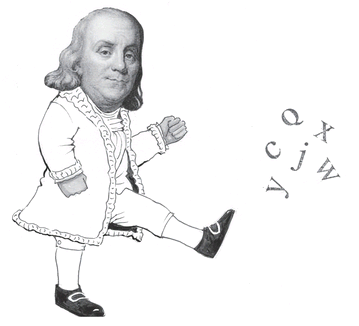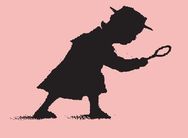The Word Snoop (3 page)
Authors: Ursula Dubosarsky


Mark Twain thought the best idea would be to make the alphabet shorter. (Hooray!) But on the other side of the world, the Irish playwright George Bernard Shaw thought exactly the opposite. (Uh-oh.) He wanted to make the alphabet longer, with more letters for all the different sounds. Even though this might make learning to read and write seem harder at first, he was sure it would be worth it in the long run.
When Shaw died in 1950, he left instructions in his will for an “invent-a-new-sensible-alphabet” competition. A man called Kingsley Read won the prize of 500 pounds, or about 678 dollars, with his invention of the “Shavian alphabet.” But only one book was ever published in this alphabet, a play called
Androcles and the Lion
by—you guessed it—George Bernard Shaw!
Invent your own AlphabetAndrocles and the Lion
by—you guessed it—George Bernard Shaw!
All these people were trying to be useful (well, let’s hope so) with their different alphabets. But what about inventing a whole new alphabet just for fun?
That’s what J.R.R. Tolkien, the writer of
The Lord of the Rings,
did. He made up an Elvish alphabet, inspired by runes, for writing his own invented Elvish language. He’d been making up languages and alphabets since he was a schoolboy.
The Lord of the Rings,
did. He made up an Elvish alphabet, inspired by runes, for writing his own invented Elvish language. He’d been making up languages and alphabets since he was a schoolboy.
Here’s an example of Tolkien’s Elvish script:


The makers of
Star Trek
also invented a special alphabet for the fictional language Klingon. And in the
Star Wars
movies the language Aurebesh has its own script too. Here’s what it looks like:

Star Trek
also invented a special alphabet for the fictional language Klingon. And in the
Star Wars
movies the language Aurebesh has its own script too. Here’s what it looks like:

Can you guess what I’ve written? (Yes, my name does look rather strange . . . )
Now, if you were to make up your own alphabet, how would you go about it? You could start with another alphabet, as Tolkien did with runes, and play around with it and change it until you make it your own. Or you could invent something entirely new.
Try using the shapes of things you see around you. Remember the Phoenician alphabet? Those letters started off as pictures of things that the Phoenicians saw in their everyday life. For example, their word for ox was “aleph,” so the letter we know as A was originally a picture of the head of an ox. B or “beth” was a house, C or “gimel” was a camel, and D or “daleth” was a door, and so on. Over time with lots of drawing, the picture became simpler and simpler, till you couldn’t tell how it had started off.

So for the letter for the sound
C
, for instance, you could draw a very simple picture, say, of a Cat. Or a Computer. Or a Cake. Or a Coconut.
C
, for instance, you could draw a very simple picture, say, of a Cat. Or a Computer. Or a Cake. Or a Coconut.
Or a . . . actually, I think I’ll leave it to you!
ShorthandShorthand? What’s that?
I can tell you one thing, you don’t need a short hand to write it, but it sure takes a short time!
Have a look at this:


You might think this is just a lot of crazy squiggles that mean nothing at all. But actually it’s not. Shorthand is not really an alphabet, but a special way of writing with symbols so that you can put down on paper very, very quickly what people are saying out loud. You can write with shorthand far more quickly than if you tried to write something down the ordinary way.
There are thousands of different shorthand systems, going right back to the ancient Greeks and Romans. The most famous is probably one called Pitman, invented by Englishman Sir Isaac Pitman in 1837. Usually journalists or court reporters use shorthand, so we can have a record of what people said. Nowadays there are computers with special keyboards so that you can type shorthand, which is even faster than writing it.
But shorthand has also been used as a way of writing secrets. Way back in the sixteenth century, Englishman Timothy Bright published a guide to his own shorthand, called
An Arte of Shorte, Swifte and Secrete Writing by Character.
(Sounds good for us Word Snoops, doesn’t it?) And one of the most remarkable diary-keepers in all history, Englishman Samuel Pepys (pronounced
Peeps
), wrote 3,000 pages of his diary in such a particular shorthand that when he died no one could understand it. It took a lot of people over a hundred years to finally “translate” it back into English.
An Arte of Shorte, Swifte and Secrete Writing by Character.
(Sounds good for us Word Snoops, doesn’t it?) And one of the most remarkable diary-keepers in all history, Englishman Samuel Pepys (pronounced
Peeps
), wrote 3,000 pages of his diary in such a particular shorthand that when he died no one could understand it. It took a lot of people over a hundred years to finally “translate” it back into English.
So if you knew shorthand, you could keep your own diary and write all sorts of secret messages with it. Like the squiggles on page 18—if you don’t know shorthand, it could mean anything. I’ll give you a hint, though.
The cat sat on . . .
Okay, okay, you guessed it!
The cat sat on . . .
Okay, okay, you guessed it!

Psst, Word Snoops! Remember how I mentioned a secret message at the start of this book? Well, here’s the first part. But you’ll have to crack the special code if you want to know what I’m saying. (Hint: Think about the alphabet, backward and forward . . .)
MLD GSZG BLF SZEV
Dear Snoops,
Have you ever noticed how strange English is?
For one thing, it has a lot of strange rules,
especially for spelling. But what’s worse, it has
even more strange exceptions. An exception is
something that breaks the rule. English has
LOTS of very odd exceptions.
especially for spelling. But what’s worse, it has
even more strange exceptions. An exception is
something that breaks the rule. English has
LOTS of very odd exceptions.
But why? That’s exactly what I wondered,
and I can tell you it took some pretty extreme
snooping to find out.
and I can tell you it took some pretty extreme
snooping to find out.
Are you ready? You need to be sitting down
in a nice, quiet, comfortable spot
for this particular story . . .
in a nice, quiet, comfortable spot
for this particular story . . .
Your comrade in espionage,
The Word Snoop

2.
Why is English so strange?
Silent LettersS
hhh! It’s time to talk about silent letters.
hhh! It’s time to talk about silent letters.
You know those pesky silent letters. They’re the ones that creep sneakily into words at the beginning, middle, or end when you’re not expecting them. Like the
k
in
k
nife, the
gh
in ni
gh
t, or the
b
in com
b
. (Aaagh! What are you doing there, silent letters! You frightened me!)
k
in
k
nife, the
gh
in ni
gh
t, or the
b
in com
b
. (Aaagh! What are you doing there, silent letters! You frightened me!)
Have a look at this sentence:
The handsome ghost wriggled through
the castle in half an hour.
the castle in half an hour.
Can you count how many silent letters there are? Eight? Or perhaps even more? Count them up for yourself. Come on, don’t be silent . . .
English is not the only language with silent letters, but it has more than most. In fact, about 60 percent of words in English have a silent letter in them. This can be really hard when you’re learning to spell, as you’ve probably realized already.

Other books
Assignment - Manchurian Doll by Edward S. Aarons
Spring Flirting(Part 2 in Naked Rose Series) by Rosalie Banks
Game of Mirrors by Andrea Camilleri
Tin Angel by Raine English
Scorched - Book Four - The Surrender Series by Anne, Melody
Neighbor Dearest by Penelope Ward
Escape From Dinosauria (Dinopocalypse Book 1) by Bilof, Vincenzo, Booth III, Max
The Neon Bible by John Kennedy Toole
Vita Nostra by Dyachenko, Marina, Dyachenko, Sergey